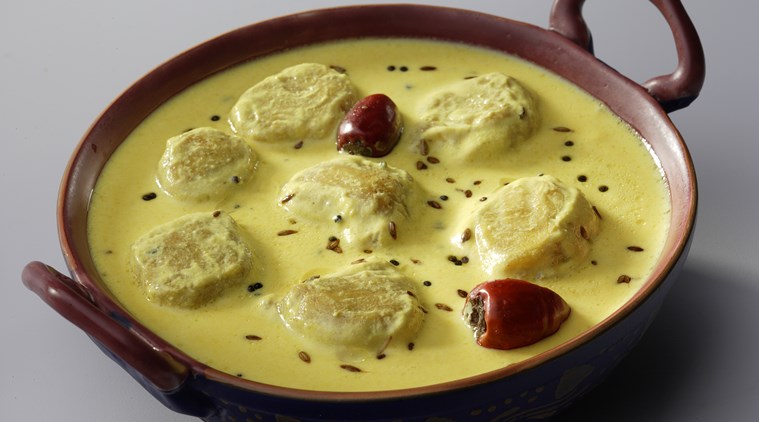📣 For more lifestyle news, click here to join our WhatsApp Channel and also follow us on Instagram
Kadhi: Why you shouldn’t avoid it this winter
Should you consume kadhi at night? Find out here.
 Kadhi has various benefits for health. (Photo: Getty Images/Thinkstock)
Kadhi has various benefits for health. (Photo: Getty Images/Thinkstock)
There are some dishes that everyone enjoys, and one of them is kadhi — the Indian yoghurt and gram flour curry that is served with rice or roti. Made differently in different regions across the country, kadhi is known for its distinct taste and aroma. But it is not just the taste, the gravy dish is also healthy considering it is loaded with vitamins and minerals which help improve body functions. Kadhi-chawal has always been a delicious combination, and tastes divine when served with a portion of fried potatoes.
The dish is rich in protein, calcium and phosphorous. So if you are a kadhi lover, here is some good news for you.
*Besan kadhi includes besan (chickpea flour) and chaach as the main ingredients. Besan has more good fat and protein than whole wheat flour. It is rich in complex carbohydrates, folate and has a low glycemic index. Chaach helps in losing weight, building your immunity, and is also good for the heart.
*A cup of kadhi consumed regularly can be beneficial for your skin and hair, as gram flour boosts collagen formation and has anti-inflammatory properties. Be it acne, dark spots or any skin issue.
*Kadhi is also a recommended diet for pregnant women as it is rich in folate, vitamin B6 and iron and ensures the growth of the baby which reduces the change of miscarriage.
 Consuming kadhi during pregnancy is considered to be beneficial for both the mother and child. (Photo: Getty Images/Thinkstock)
Consuming kadhi during pregnancy is considered to be beneficial for both the mother and child. (Photo: Getty Images/Thinkstock)
*Diabetes can also cause heart problems, and the blood pressure to rise. Kadhi helps to keep blood pressure under control and also directly controls diabetes as it is low in glycemic index and therefore helps to keep the blood sugar low and controlled, and improve insulin use in the body.
*Besan kadhi is loaded with good bacteria, which is healthy for the gut. It helps in maintaining gut flora and improves nutrient absorption. All this, in turn, helps in improving the digestion.
*Kadhi is rich in magnesium, which relaxes your muscles and helps in maintaining heart health. The phosphorus helps in regulating the lipid mechanism.
Turmeric and black pepper are known for their anti-inflammatory and anti-bacterial properties that can provide relief from severe cold. These ingredients also induce good sleep when a person is suffering from cold and cough. It is known to be a winter comfort food and can surely be had in winter, but have it warm and not out of the refrigerator. Many people say that because of its sour nature, it is best to not have it at night time.
How to make it
Every house has its own unique way of making this dish. There is not much similarity between a Gujarati kadhi, Sindhi kadhi, Rajasthani kadhi, Bohri kadhi or a UP kadhi except that all are yoghurt-based (except sindhi kadhi which has a tamarind base) and it may or may not have pakodi (gram flour dumplings, and those too vary from one cuisine to another) and other veggies. Its consistency can also vary; Gujarati kadhi is thin and also sweetish. Sindhi kadhi has loads of vegetables in it and tamarind pulp is added for sourness. But whatever way you like it, kadhi always tastes good, is very simple to make and can be had any time of the year.
Here’s a quick recipe of Gujarati Kadhi by Ashima Goyal Siraj
Preparation Time: 10 mins| Cooking Time: 15 mins| Serves 2
Ingredients
2 cups – Skimmed milk yoghurt
1 1/2tbsp – Gram flour (besan)
1tbsp – Grated jaggery
1 no – Chopped green chilli
1/2tsp – Fenugreek seeds
1/2tsp – Mustard seeds
1/2tsp – Cumin seeds
1tsp – Ginger paste
8-10 no- Curry leaves
1 no – Dried red chilli, broken into two
3-4 no – Cloves
1/2 inch – Cinnamon stick
A pinch of asafoetida
Salt to taste
1tbsp – Olive oil
Method
*Whisk together yoghurt, gram flour and four cups of water to make a smooth paste.
*Add the chopped green chillies and jaggery. Mix well.
*Cook the yoghurt mixture on low-medium heat, stirring continuously until the yoghurt boils. After that reduce the heat to low and let the kadhi cook until it attains a moderately thick consistency. Stir occasionally.
Note: Remember not to boil the kadhi on high flame as it tends to curdle.
*For tempering, heat oil in a small pan (preferably a tadka pan). Add the fenugreek, cumin and mustard seeds, curry leaves, red chillies, cloves, cinnamon and asafoetida. When the seeds begin to sputter, pour the tempering (tadka) into the kadhi and mix well.
*Serve hot with rice or khichdi or have it as soup.
📣 For more lifestyle news, click here to join our WhatsApp Channel and also follow us on Instagram
Photos



- 01
- 02
- 03
- 04
- 05
























